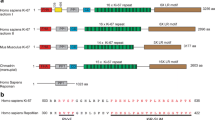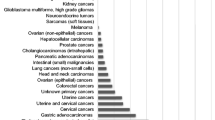Abstract
Abnormal translation of mRNAs frequently occurring during carcinogenesis is among the mechanisms that can affect the expression of proteins involved in tumor development and progression. Eukaryotic initiation factor eIF4E is a key regulator of translation of many cancer-related transcripts and its expression is altered in various cancers and has been associated with worse survival. We determined the eIF4E protein levels using immunohistochemistry (IHC) in 1,233 breast tumors on tissue microarrays. We analyzed the effects of the IHC expression level on tumor characteristics and patient survival, also with stratification by adjuvant chemotherapy treatment. In 1,085 successfully stained tumors, high level of eIF4E protein expression was associated with features of aggressive tumor phenotype, namely grade, estrogen and progesterone receptor negativity, HER2 receptor positivity, and high expression of p53 and Ki67, and with triple negative subtype (p < 0.001). High eIF4E expression was associated with worse breast cancer-specific survival with a hazard ratio (HR) of 1.99 (95 % CI 1.32–3.00, p = 0.0008) and was in a multivariate analysis an independent prognostic factor. High eIF4E expression was associated with worse outcome also after detection of distant metastasis (HR = 1.88, 95 % CI 1.20–2.94, p = 0.0060). In the subgroup analysis the survival effect was strongest among patients treated with anthracycline chemotherapy (HR = 3.34, 95 % CI 1.72–6.48, p = 0.0002), whereas no such effect was seen among patients who had not received anthracycline with significant difference in heterogeneity between the two groups (p = 0.0358). High expression of eIF4E is associated with adverse tumor characteristics and predicts poor breast cancer-specific survival. This effect is emphasized in patients treated with anthracycline chemotherapy. eIF4E as a treatment predictive factor warrants further studies.



Similar content being viewed by others
Abbreviations
- 4E-BP:
-
eIF4E-binding protein
- CEF:
-
Cyclophosphamide, epirubicin, and fluorouracil treatment
- CISH:
-
Chromogenic in situ hybridization
- CMF:
-
Cyclophosphamide, methotrexate, and fluorouracil treatment
- eIF4E:
-
Eukaryotic initiation factor 4E
- ER:
-
Estrogen receptor
- HR:
-
Hazard ratio
- IHC:
-
Immunohistochemistry
- mAb:
-
Monoclonal antibody
- MMP-9:
-
Matrix metalloptotease 9
- mTOR:
-
Mammalian target for rapamycin
- OR:
-
Odds ratio
- PI3K:
-
Phosphatidylinositol-3-kinase
- PR:
-
Progesterone receptor
- PTEN :
-
Phosphatase and tensin homolog
- TLK1B:
-
Tousled-like kinase 1B
- TMA:
-
Tissue microarray
- VEGF:
-
Vascular endothelial growth factor
References
Pandolfi PP (2004) Aberrant mRNA translation in cancer pathogenesis: an old concept revisited comes finally of age. Oncogene 23:3134–3137
Shaw RJ, Cantley LC (2006) Ras, PI(3)K and mTOR signalling controls tumour cell growth. Nature 441:424–430
Gingras AC, Raught B, Sonenberg N (2001) Regulation of translation initiation by FRAP/mTOR. Genes Dev 15:807–826
Ruggero D (2009) The role of Myc-induced protein synthesis in cancer. Cancer Res 69:8839–8843
Sonenberg N (2008) eIF4E, the mRNA cap-binding protein: from basic discovery to translational research. Biochem Cell Biol 86:178–183
Graff JR, Konicek BW, Carter JH et al (2008) Targeting the eukaryotic translation initiation factor 4E for cancer therapy. Cancer Res 68:631–634
De Benedetti A, Graff JR (2004) eIF-4E expression and its role in malignancies and metastases. Oncogene 23:3189–3199
Ruggero D, Montanaro L, Ma L et al (2004) The translation factor eIF-4E promotes tumor formation and cooperates with c-Myc in lymphomagenesis. Nat Med 10:484–486
Wendel HG, De Stanchina E, Fridman JS et al (2004) Survival signalling by Akt and eIF4E in oncogenesis and cancer therapy. Nature 428:332–337
Malina A, Cencic R, Pelletier J (2011) Targeting translation dependence in cancer. Oncotarget 2:76–88
Mamane Y, Petroulakis E, Rong L et al (2004) eIF4E–from translation to transformation. Oncogene 23:3172–3179
Byrnes K, White S, Chu Q et al (2006) High eIF4E, VEGF, and microvessel density in stage I to III breast cancer. Ann Surg 243:684–690
Coleman LJ, Peter MB, Teall TJ et al (2009) Combined analysis of eIF4E and 4E-binding protein expression predicts breast cancer survival and estimates eIF4E activity. Br J Cancer 100:1393–1399
Flowers A, Chu QD, Panu L et al (2009) Eukaryotic initiation factor 4E overexpression in triple-negative breast cancer predicts a worse outcome. Surgery 146:220–226
Li BD, McDonald JC, Nassar R et al (1998) Clinical outcome in stage I to III breast carcinoma and eIF4E overexpression. Ann Surg 227:756–761
Holm N, Byrnes K, Johnson L et al (2008) A prospective trial on initiation factor 4E (eIF4E) overexpression and cancer recurrence in node-negative breast cancer. Ann Surg Oncol 15:3207–3215
McClusky DR, Chu Q, Yu H et al (2005) A prospective trial on initiation factor 4E (eIF4E) overexpression and cancer recurrence in node-positive breast cancer. Ann Surg 242:584–590
Pettersson F, Yau C, Dobocan MC et al (2011) Ribavirin treatment effects on breast cancers overexpressing eIF4E, a biomarker with prognostic specificity for luminal B-type breast cancer. Clin Cancer Res 17:2874–2884
Tommiska J, Eerola H, Heinonen M et al (2005) Breast cancer patients with p53 Pro72 homozygous genotype have a poorer survival. Clin Cancer Res 11:5098–5103
Syrjakoski K, Vahteristo P, Eerola H et al (2000) Population-based study of BRCA1 and BRCA2 mutations in 1035 unselected Finnish breast cancer patients. J Natl Cancer Inst 92:1529–1531
Kilpivaara O, Bartkova J, Eerola H et al (2005) Correlation of CHEK2 protein expression and c.1100delC mutation status with tumor characteristics among unselected breast cancer patients. Int J Cancer 113:575–580
Eerola H, Blomqvist C, Pukkala E et al (2000) Familial breast cancer in southern Finland: how prevalent are breast cancer families and can we trust the family history reported by patients? Eur J Cancer 36:1143–1148
Vahteristo P, Eerola H, Tamminen A et al (2001) A probability model for predicting BRCA1 and BRCA2 mutations in breast and breast-ovarian cancer families. Br J Cancer 84:704–708
Eerola H, Heikkila P, Tamminen A et al (2005) Histopathological features of breast tumours in BRCA1, BRCA2 and mutation-negative breast cancer families. Breast Cancer Res 7:R93–R100
Tommiska J, Bartkova J, Heinonen M et al (2008) The DNA damage signalling kinase ATM is aberrantly reduced or lost in BRCA1/BRCA2-deficient and ER/PR/ERBB2-triple-negative breast cancer. Oncogene 27:2501–2506
Ahlin C, Aaltonen K, Amini RM et al (2007) Ki67 and cyclin A as prognostic factors in early breast cancer. What are the optimal cut-off values? Histopathology 51:491–498
Aaltonen K, Blomqvist C, Amini RM et al (2008) Familial breast cancers without mutations in BRCA1 or BRCA2 have low cyclin E and high cyclin D1 in contrast to cancers in BRCA mutation carriers. Clin Cancer Res 14:1976–1983
McShane LM, Altman DG, Sauerbrei W et al (2005) Reporting recommendations for tumor marker prognostic studies (REMARK). J Natl Cancer Inst 97:1180–1184
Therneau T (2002) A Package for Survival Analysis in S. R package version 2.36-12
Peduzzi P, Concato J, Feinstein AR et al (1995) Importance of events per independent variable in proportional hazards regression analysis. II. Accuracy and precision of regression estimates. J Clin Epidemiol 48:1503–1510
Kleiner HE, Krishnan P, Tubbs J et al (2009) Tissue microarray analysis of eIF4E and its downstream effector proteins in human breast cancer. J Exp Clin Cancer Res 28:5
Byrnes KW, DeBenedetti A, Holm NT et al (2007) Correlation of TLK1B in elevation and recurrence in doxorubicin-treated breast cancer patients with high eIF4E overexpression. J Am Coll Surg 204:925–933
Beslija S, Bonneterre J, Burstein HJ et al (2009) Third consensus on medical treatment of metastatic breast cancer. Ann Oncol 20:1771–1785
Hsieh AC, Ruggero D (2010) Targeting eukaryotic translation initiation factor 4E (eIF4E) in cancer. Clin Cancer Res 16:4914–4920
Wendel HG, Silva RL, Malina A et al (2007) Dissecting eIF4E action in tumorigenesis. Genes Dev 21:3232–3237
Ding Q, He X, Xia W et al (2007) Myeloid cell leukemia-1 inversely correlates with glycogen synthase kinase-3beta activity and associates with poor prognosis in human breast cancer. Cancer Res 67:4564–4571
Li Y, DeFatta R, Anthony C et al (2001) A translationally regulated Tousled kinase phosphorylates histone H3 and confers radioresistance when overexpressed. Oncogene 20:726–738
Sunavala-Dossabhoy G, Fowler M, De Benedetti A (2004) Translation of the radioresistance kinase TLK1B is induced by gamma-irradiation through activation of mTOR and phosphorylation of 4E-BP1. BMC Mol Biol 5:1
Acknowledgments
We thank research nurses Irja Erkkilä and Virpi Palola for their assistance with data management, and the Finnish Cancer Registry for the cancer diagnostic and follow-up data. The study was supported by funding from the Helsinki University Central Hospital Research Fund, the Sigrid Juselius Foundation, the Finnish Cancer Society, and the Academy of Finland (132473), and for TH by the Finnish Cultural Foundation, Paulo foundation, Ida Montin foundation, and Orion-Farmos research foundation. TK is a member of Turku doctoral program of biomedical sciences.
Conflict of interest
The authors declare that they have no conflict of interest.
Author information
Authors and Affiliations
Corresponding author
Rights and permissions
About this article
Cite this article
Heikkinen, T., Korpela, T., Fagerholm, R. et al. Eukaryotic translation initiation factor 4E (eIF4E) expression is associated with breast cancer tumor phenotype and predicts survival after anthracycline chemotherapy treatment. Breast Cancer Res Treat 141, 79–88 (2013). https://doi.org/10.1007/s10549-013-2671-2
Received:
Accepted:
Published:
Issue Date:
DOI: https://doi.org/10.1007/s10549-013-2671-2




